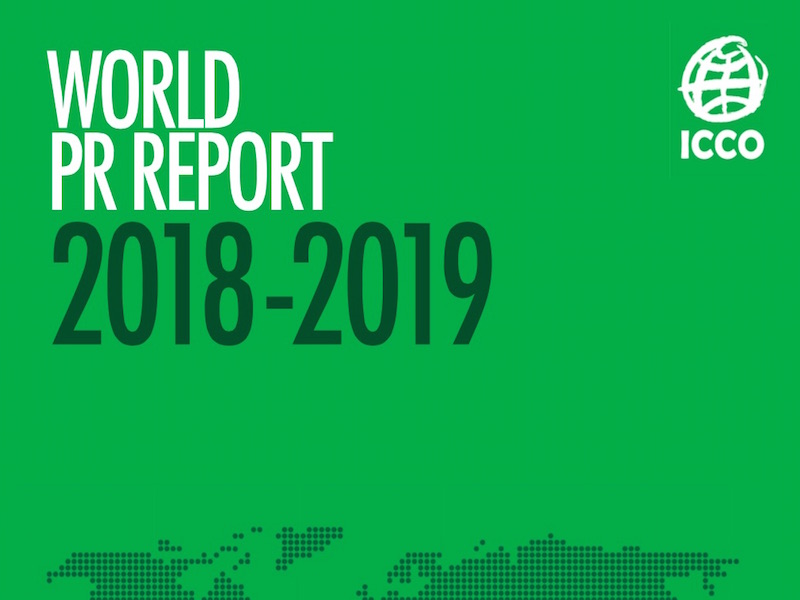Maja Pawinska Sims 27 Nov 2018 // 1:30AM GMT

SINGAPORE — The ICCO World PR Report 2018-2019, launched today, reveals agency heads in every region of the world are predicting increased profitability this year compared with last year, and are broadly optimistic about the state of the global PR industry.
The report, now in its fifth year, aims to take the temperature of the global PR industry and identify areas of growth, expectations for investment, and future challenges.
On a scale of 1-10, the global average for optimism is 7.7, on a par with last year (7.8). The most optimistic markets are Africa (7.9) and Asia (7.8). The least optimistic regions are the Middle East (6.6) and Eastern Europe (6.6). North America was somewhere in the middle with a score of 7.1, around the same level as Western Europe (7.2). The UK was slightly higher at 7.3.
When asked about expectations of profitability, the global average is slightly up, at 6.9, compared to 6.4 last year. Asia came in highest with a score of 7.7, followed by Western Europe at 7.2 (although, perhaps because of Brexit, the UK came in lower, at 6.3). Africa came in lowest at 6.1. North American agency heads were among the least optimistic, with a score of 6.2.
ICCO chief executive Francis Ingham said: “In every region of the world, agencies expect to be more profitable this year than last. And given the uncertain times in which we work, that speaks volumes. CEOs continue to increase financial investment in their corporate reputation, while investor activism and social media transparency have intensified the focus on delivering not just good numbers, but doing so with integrity. These trends have helped fuel demand for senior counsel.
“All around the world, PR is growing in size and in influence. Our time in the sun is now – and in the years to come.”
Nearly half of the agency heads surveyed say they predict growth in the year ahead to come from corporate reputation, while 44% say digital communications will grow and 39% expect growth from social responsibility, linked to the trend for agencies and clients to focus on brand purpose. The fourth area where growth is predicted is the newly-prominent area of employee communications (35%).
The sectors where growth is expected over the next year mirror those where growth was experienced this year, topped by technology (55%), healthcare (41%) and consumer products (34%). Although financial and professional services only grew for 5% of respondents this year, there is a huge leap to 33% of those who think this will be a growth area in 2019.
Social media community management tops the list of areas where respondents say they expect increased investment over the next few years, at 43%. This is followed by content creation (41%), digital build/production (35%), measurement and analytics (28%) and creativity (27%).
In terms of the main challenges, global agency heads mirrored the main concerns of those in Europe, outlined in a preview of the report at the ICCO Global Summit in Dublin last month. Client-agency relationships are a huge issue, including clients not committing sufficient funds (38%, up from 22% last year), clients being too focused on the short-term (34%, up from 11% last year) and lack of understanding of PR (31%). This is closely followed by competition from other marketing disciplines (30%, up from 19% last year).
Talent is another key issue. Retaining key staff is the top talent-related challenge (61%, up from 45% last year), followed by training and developing mid-level staff (35%). Hiring senior staff, hiring people from non-traditional backgrounds and motivating younger executives all hovered around the 30% mark as predicted talent challenges.
The talent pool for the industry is still overwhelmingly other agencies: 80% of respondents said they would look for talent from their rivals. In-house teams (20%) and journalism (21%) were the next two biggest sources of potential talent, followed by advertising and marketing (18%) and research and analytics (11%).
The measurement picture is slowly improving: the report reveals that 48% of global respondents never use AVEs, up from 44% in 2017. The main global reason given for the continued use of AVEs is that it is expected by clients (26%). The existence of AVEs is highest in the Middle East, where only 15% report that they do not ever use them.
Ingham said proving PR’s value was critical to accessing bigger client budgets but said progress on measurement was being made: “Clients not committing sufficient funds relates clearly to our inability to still fully prove our value. And that in turn relates to our under-investment in evaluation. But we should also acknowledge progress here. In every region of the world, those saying AVEs are their preferred method of evaluation has fallen. Evaluation becomes more sophisticated with each passing year.”
The Global Women in PR (GWPR) survey results are also included in the report. GWPR joint president Angela Oakes said 2018 had been a “watershed year for women” but there is more work to be done: 65% of organisations are still not monitoring their gender pay gap,
The research confirmed that family commitments and parental leave arrangements are the biggest barrier to women reaching leadership positions in the industry: 58% of respondents agreed or strongly agreed with this statement.
Despite moves being made towards more flexible workplaces, the culture of presenteeism persists: only 67% of organisations allow employees to work from home on a regular basis. And while 68% of agencies have a parental leave programme in place, three quarters of those that take this are women and only 25% plan to take joint parental leave with their partner.
The report also includes the Holmes Report’s Top 250 Global Agency Rankings.


































.jpg)





.tmb-135x100.jpg)











